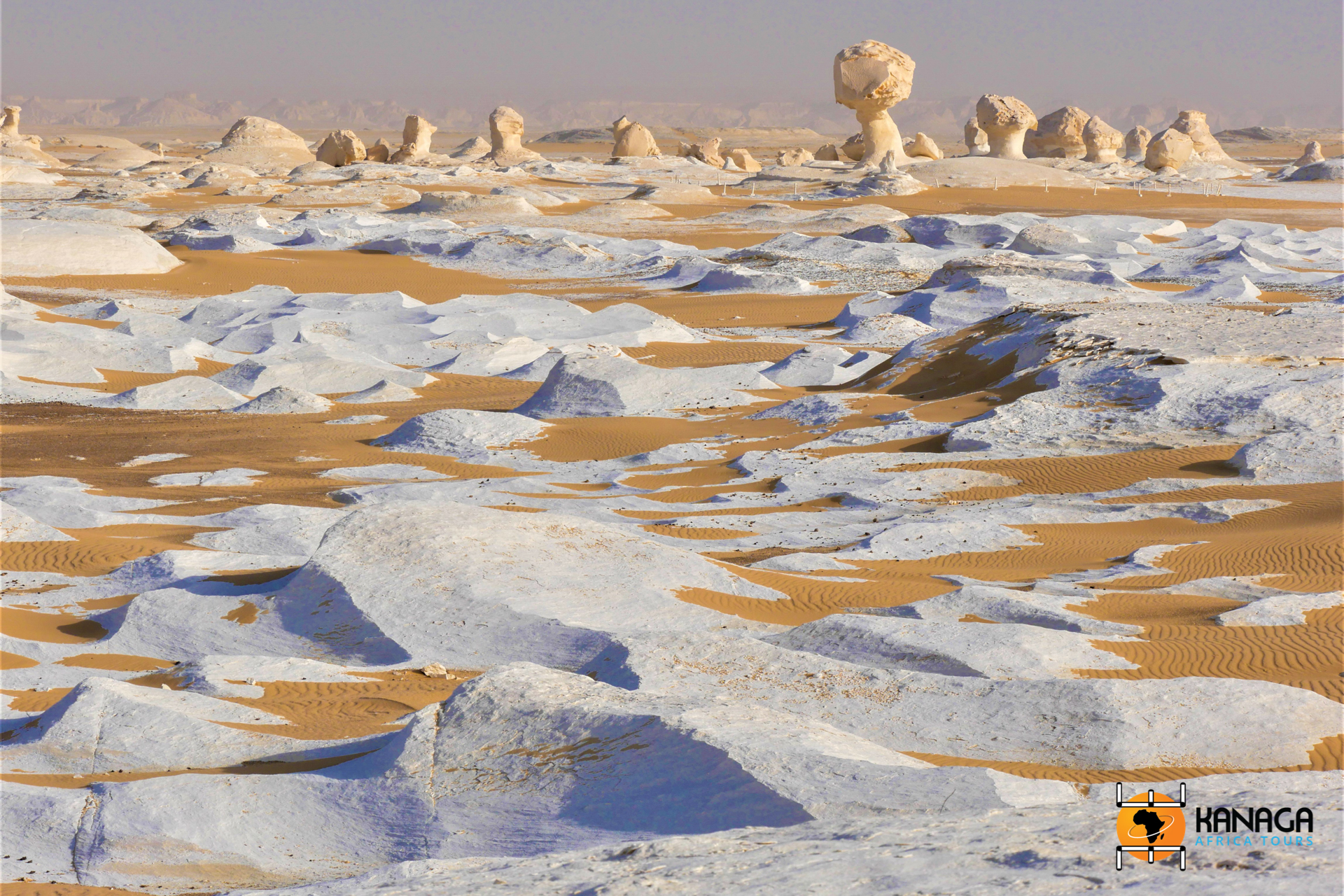© M. Santoro
In the desert hinterland, parallel to the stream of the Nile river, lies the fascinating region of the ancient Western Oases, strategic centres along the caravan routes between the Nile Valley and Libya in Pharaonic times, and important agricultural outposts for wheat, grapes, olive oil and dates in Roman times.
True gardens, irrigated by underground aquifers that emerge from the desert sands, the Baharia and Farafra oases, and those of Kahrga and Dakhla further south, are also precious treasure chests of ancient archaeological remains that bring to light the splendours of past Pharaonic civilisations, fortified Roman outposts and Christian settlements, winding their way along an itinerary of enormous historical interest, where the spectacular desert landscapes are a constant feature.
An impressive setting that varies from the lunar landscapes of the dark basalt cones of the Black Desert (Sahara Souda), to the bizarre conformations of the Crystal Mountain with its large calcite crystals, to the depressions where ancient marine sediments give rise to curious terrain morphologies called “mud lions” (yardangs), to the natural lakes bordered with greenery or the hot springs that suddenly appear in the middle of nowhere, hides in underground depths thick with stalactites and stalagmites in Djara Cave, and finally opens up into the vast and spectacular White Desert (Sahara el Beyda), heralded by the outlines of Twin Peaks, and running through a breathtaking and blinding expanse of white deposits, which stain the golden sand like a snowy mantle, articulating here and there in surreal formations modelled by atmospheric agents, natural sculptures of pinnacles, mushrooms and limestone shells, white sediments of shells and micro-organisms, forgotten there by the retreating sea waters. This is one of the most fascinating landscapes in the Sahara.
Amidst these boundless desert scenarios, Oases appear, surrounded by basaltic heights or conical mountains, in depressions in which small lush universes survive, worlds in themselves of fertile irrigated land, which saw the succession of the most important civilisations of the past, amidst miraculous gardens growing in the middle of the desert.
The Kharga Oasis, the most populous and southern, has been inhabited since the Neolithic period, but it experienced a strong expansion in Ptolemaic times, taking the name of Hibis in the 3rd century B.C., and was subsequently endowed with numerous Roman fortresses, still splendidly preserved today at Ain Umm Dabadib and Qasr Labeka. A visit to the rich Museum of Kharga will give an idea of the importance of Kharga and the Western Oasis Region over the ages, from prehistoric times to the Coptic period. The undisputed jewel of the Oasis is the oldest Christian necropolis in Bagawat, a vast complex of domed mud-brick chapels dating from the 4th/6th centuries AD, with beautifully preserved Old Testament frescoes with Hellenistic influences. The nearby Ibis Temple, dedicated to Amenebis and Osiri, is the largest building constructed in the oasis, dating back to the time of the Pharaonic XXVI Dynasty and completed in Persian times under Darius I and Ptolemy II, together with the Qasr el-Gueita Temple.
There are many points of interest between the Kharga Oasis and the Dakhla Oasis, from the picturesque villages of Bashendi and Balat, both of which date back to the Middle Ages, to the most important necropolis in the Western Desert at Qila el-Dabba, where seven unbaked brick mastadas dating back to the 6th Dynasty and dedicated to the cult of the dead have been found, splendidly decorated and complete with rich vestments, now kept in the Kharga Museum.
The Dakhla Oasis is home to the ancient Ottoman village of El-Qasr, with its narrow alleyways and ancient dwellings with characteristic decorated wooden lintels. The archaeological gem of the area is the spectacular necropolis consisting of 300 Muzawaqa tombs, with splendid decorations typical of the Pharaonic period but in a style influenced by Greco-Roman influences, of which the two main ones, dedicated to the officials Petosiris and Petubastis, date back to the 2nd century AD. The nearby Temple of Deir el-Hagar, dedicated to Amon-Ra , Mut and Khonsu (the Theban triad), is instead a magnificent example built under Nero in the 1st century AD.
Heading north towards the Farafa Oasis, you will be enraptured by the immensity of the spectacular scenery of the White Desert and the numerous hot springs, before finally reaching the Baharia Oasis, the ancient land of dinosaurs, which preserves imposing Roman fortresses, the ancient Pharonic tomb of Amenhotep-Huy, from the 18th Dynasty and the famous Alexander the Great Temple, which the conqueror had built after his trip to the Oracle of Siwa. But above all, the Valley of the Golden Mummies, an immense Roman necropolis that still preserves perfectly preserved and richly furnished mummies, many of which have been moved to the Inspectorate of Antiquities, as precious treasures with the special technique of cartonnage, a covering of linen bandages covered with a layer of gold, in turn decorated with the reproduction of the features of the deceased, in correspondence of the face. The four chapels of Ain el-Muftella, dating back to the XXVI Dynasty, are splendid examples of the Pharaonic period, with magnificent bas-reliefs dedicated to the Egyptian pantheon, and the incredible funerary site of the two tombs of Qaret Qasr Selim, dug into the rock of the Bawiti hill and richly decorated with brightly coloured frescoes, which present a particularly complex iconography of religious scenes connected to the funeral rite.
If the security situation improves, an itinerary through the Western Oases could be brought to a close with an expedition to Gilf Kebir, on the Libyan border, a thousand-year-old jewel that contains precious examples of rock art among the rocky walls of the Sahara.







